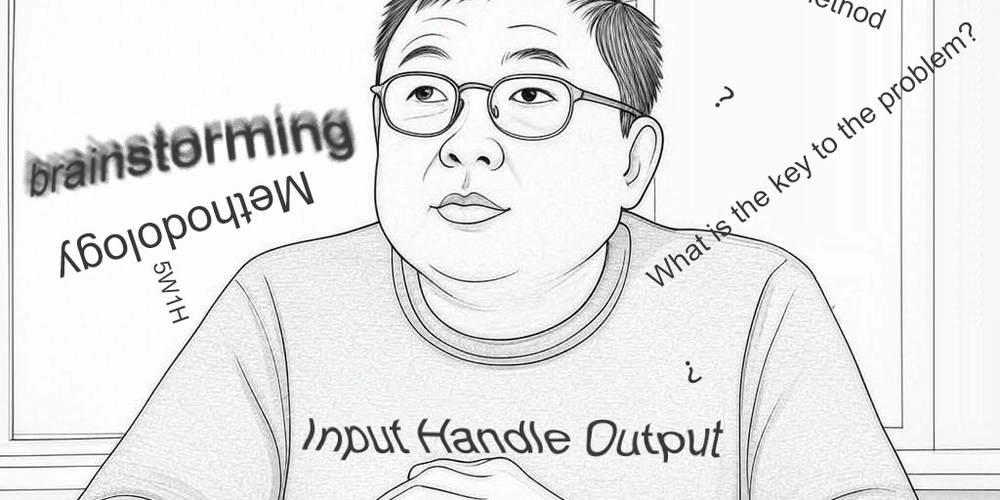How Deductive Thinking Solves Problems
In daily life and work, we often encounter various complex problems. How can we efficiently solve these problems? Deductive thinking is a powerful tool that helps us draw conclusions from known facts or rules, allowing us to make accurate decisions. 1. What is Deductive Thinking? Deductive thinking is a reasoning process that works from the general to the specific. It starts with a universal principle and uses it to derive a specific conclusion based on the circumstances. Its basic logical structure is: Major Premise (General Law) — Known theories or facts. Minor Premise (Specific Situation) — The particular case being considered. Conclusion (Derived Result) Example: Major Premise: All humans will die. Minor Premise: John is a human. Conclusion: John will die. 2. How Does Deductive Thinking Solve Problems? In practice, we can use deductive thinking to analyze problems and make decisions. Here’s how: 1. Identify the Known Rule (Major Premise) To apply deductive reasoning, we first need to identify a recognized rule or principle. This rule often comes from experience, scientific laws, logical principles, etc. Example: In company management, "Higher employee satisfaction typically leads to higher productivity." 2. Analyze the Specific Situation (Minor Premise) Next, we analyze the specific details of the problem at hand to see if they align with the major premise. Example: Employees in a company have reported dissatisfaction with their salaries and low job satisfaction. 3. Logical Deduction (Draw the Conclusion) We then use deductive reasoning to logically deduce a conclusion based on the premises. Example: Major Premise: Low employee satisfaction usually affects productivity. Minor Premise: Employees at this company have low satisfaction. Conclusion: The company may be experiencing lower productivity due to this. 4. Take Action, Verify the Conclusion After drawing the conclusion, we need to test and verify it through action. Possible solutions: Increase salaries, improve the work environment, offer additional employee benefits, etc. Test whether these actions improve productivity. 3. Real-World Examples of Deductive Thinking Example 1: Marketing Strategy Problem: An e-commerce company notices a decline in sales. How can they find the cause? Deductive Analysis: Major Premise: If customer churn increases, it is usually due to product, pricing, service, or marketing issues. Minor Premise: Data shows a rise in customer churn, particularly among loyal customers. Conclusion: The decline in sales may be caused by unmet needs among long-term customers. Action Plan: Survey loyal customers to understand why they’re leaving (e.g., product quality, price advantage from competitors, etc.). Implement a loyalty program, offer extra benefits or discounts to keep them engaged. Example 2: Bug Analysis in Software Development Problem: A software crashes under certain conditions. How can we identify the issue? Deductive Analysis: Major Premise: Software crashes are usually due to coding errors, insufficient resources, or environmental issues. Minor Premise: The issue occurs only on specific devices, and logs show memory usage spikes. Conclusion: The crash is likely due to a memory leak. Action Plan: Use memory analysis tools (e.g., Valgrind) to detect leaks. Optimize the code to release unnecessary resources. Example 3: How to Become Wealthy? Problem: Many people aspire to become wealthy but struggle to understand the steps needed. What is the formula for achieving wealth? Deductive Analysis: Major Premise: Wealth is built by managing the difference between income and expenses effectively. Minor Premise: To accumulate wealth, one must focus on increasing income and reducing unnecessary expenses. Conclusion: The key to becoming wealthy is maximizing your savings by ensuring income is greater than expenses, and then wisely investing that surplus. Action Plan: Increase Income: Seek ways to boost your income, such as advancing in your career, starting a side hustle, or investing in assets that generate passive income. Reduce Expenses: Cut back on unnecessary spending, prioritize needs over wants, and be mindful of your budget. Save and Invest: The money you save from the difference between income and expenses should be invested in wealth-building assets like stocks, real estate, or businesses. Formula: Wealth = Income - Expenses (and Invest the Difference). 4. Deductive Thinking vs. Inductive Thinking When solving problems, deductive thinking and inductive thinking are often compared: Thinking Style Direction of Logic Best Used For Deductive Thinking General to Specific Ideal for problems with well-established principles, like legal reasoning, scientific research, or mathematical proof Inductive Thinking Specifi

In daily life and work, we often encounter various complex problems. How can we efficiently solve these problems? Deductive thinking is a powerful tool that helps us draw conclusions from known facts or rules, allowing us to make accurate decisions.
1. What is Deductive Thinking?
Deductive thinking is a reasoning process that works from the general to the specific. It starts with a universal principle and uses it to derive a specific conclusion based on the circumstances.
Its basic logical structure is:
- Major Premise (General Law) — Known theories or facts.
- Minor Premise (Specific Situation) — The particular case being considered.
- Conclusion (Derived Result)
Example:
- Major Premise: All humans will die.
- Minor Premise: John is a human.
- Conclusion: John will die.
2. How Does Deductive Thinking Solve Problems?
In practice, we can use deductive thinking to analyze problems and make decisions. Here’s how:
1. Identify the Known Rule (Major Premise)
To apply deductive reasoning, we first need to identify a recognized rule or principle. This rule often comes from experience, scientific laws, logical principles, etc.
- Example: In company management, "Higher employee satisfaction typically leads to higher productivity."
2. Analyze the Specific Situation (Minor Premise)
Next, we analyze the specific details of the problem at hand to see if they align with the major premise.
- Example: Employees in a company have reported dissatisfaction with their salaries and low job satisfaction.
3. Logical Deduction (Draw the Conclusion)
We then use deductive reasoning to logically deduce a conclusion based on the premises.
- Example:
- Major Premise: Low employee satisfaction usually affects productivity.
- Minor Premise: Employees at this company have low satisfaction.
- Conclusion: The company may be experiencing lower productivity due to this.
4. Take Action, Verify the Conclusion
After drawing the conclusion, we need to test and verify it through action.
- Possible solutions: Increase salaries, improve the work environment, offer additional employee benefits, etc. Test whether these actions improve productivity.
3. Real-World Examples of Deductive Thinking
Example 1: Marketing Strategy
Problem: An e-commerce company notices a decline in sales. How can they find the cause?
Deductive Analysis:
- Major Premise: If customer churn increases, it is usually due to product, pricing, service, or marketing issues.
- Minor Premise: Data shows a rise in customer churn, particularly among loyal customers.
- Conclusion: The decline in sales may be caused by unmet needs among long-term customers.
Action Plan:
- Survey loyal customers to understand why they’re leaving (e.g., product quality, price advantage from competitors, etc.).
- Implement a loyalty program, offer extra benefits or discounts to keep them engaged.
Example 2: Bug Analysis in Software Development
Problem: A software crashes under certain conditions. How can we identify the issue?
Deductive Analysis:
- Major Premise: Software crashes are usually due to coding errors, insufficient resources, or environmental issues.
- Minor Premise: The issue occurs only on specific devices, and logs show memory usage spikes.
- Conclusion: The crash is likely due to a memory leak.
Action Plan:
- Use memory analysis tools (e.g., Valgrind) to detect leaks.
- Optimize the code to release unnecessary resources.
Example 3: How to Become Wealthy?
Problem: Many people aspire to become wealthy but struggle to understand the steps needed. What is the formula for achieving wealth?
Deductive Analysis:
- Major Premise: Wealth is built by managing the difference between income and expenses effectively.
- Minor Premise: To accumulate wealth, one must focus on increasing income and reducing unnecessary expenses.
- Conclusion: The key to becoming wealthy is maximizing your savings by ensuring income is greater than expenses, and then wisely investing that surplus.
Action Plan:
- Increase Income: Seek ways to boost your income, such as advancing in your career, starting a side hustle, or investing in assets that generate passive income.
- Reduce Expenses: Cut back on unnecessary spending, prioritize needs over wants, and be mindful of your budget.
- Save and Invest: The money you save from the difference between income and expenses should be invested in wealth-building assets like stocks, real estate, or businesses.
Formula:
Wealth = Income - Expenses (and Invest the Difference).
4. Deductive Thinking vs. Inductive Thinking
When solving problems, deductive thinking and inductive thinking are often compared:
| Thinking Style | Direction of Logic | Best Used For |
|---|---|---|
| Deductive Thinking | General to Specific | Ideal for problems with well-established principles, like legal reasoning, scientific research, or mathematical proof |
| Inductive Thinking | Specific to General | Best for discovering new patterns or theories, like market research, product innovation, or scientific discovery |
In practice, deductive and inductive thinking often work together. We may first use inductive reasoning to discover a pattern, then apply deductive thinking to apply that pattern in specific situations.










































































































































































![[The AI Show Episode 142]: ChatGPT’s New Image Generator, Studio Ghibli Craze and Backlash, Gemini 2.5, OpenAI Academy, 4o Updates, Vibe Marketing & xAI Acquires X](https://www.marketingaiinstitute.com/hubfs/ep%20142%20cover.png)



























































































































![[FREE EBOOKS] The Kubernetes Bible, The Ultimate Linux Shell Scripting Guide & Four More Best Selling Titles](https://www.javacodegeeks.com/wp-content/uploads/2012/12/jcg-logo.jpg)



![From drop-out to software architect with Jason Lengstorf [Podcast #167]](https://cdn.hashnode.com/res/hashnode/image/upload/v1743796461357/f3d19cd7-e6f5-4d7c-8bfc-eb974bc8da68.png?#)






































































































.png?#)




.jpg?#)































_Christophe_Coat_Alamy.jpg?#)








































































































![Rapidus in Talks With Apple as It Accelerates Toward 2nm Chip Production [Report]](https://www.iclarified.com/images/news/96937/96937/96937-640.jpg)









































































































































